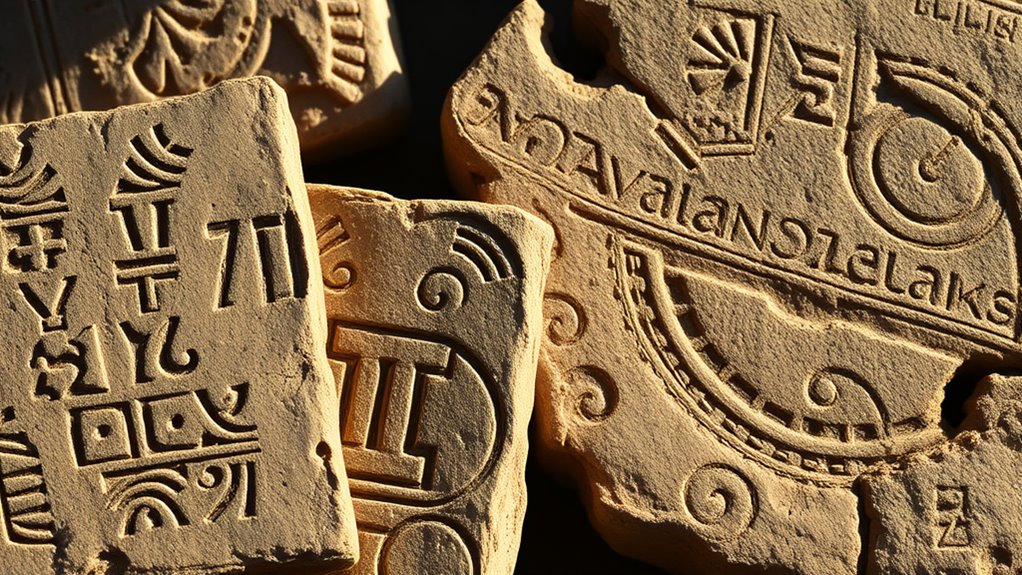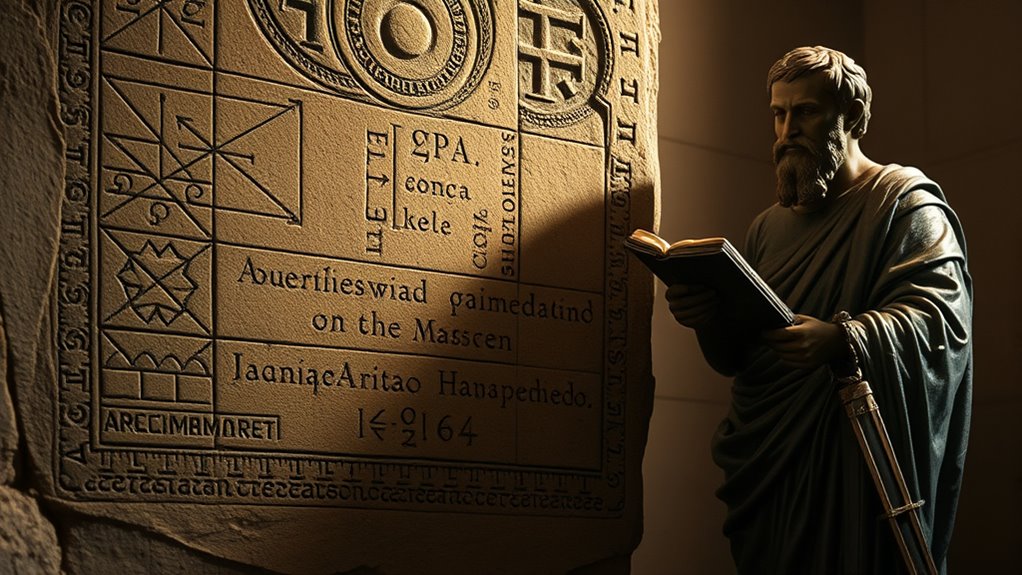Throughout history, civilizations like the Egyptians and Babylonians developed early approximations of pi, using geometric methods and methods of exhaustion pioneered by Archimedes to improve accuracy. Over time, calculus and infinite series refined these estimates further. Today, advanced algorithms and computers calculate pi to billions of digits, supporting science, engineering, and technology. Curious to see how far humans have come in understanding this constant? Keep exploring to uncover more fascinating details.
Key Takeaways
- Ancient civilizations, like Egyptians and Babylonians, used geometric methods to approximate pi, with values around 3.
- Archimedes’ polygon method refined pi estimates by inscribing and circumscribing polygons with increasing sides.
- The development of calculus and infinite series enabled more precise calculations of pi, impacting science and engineering.
- Modern algorithms and computational power now calculate pi to billions of decimal places for scientific and technological applications.
- Pi’s approximations have shaped cultural, mathematical, and practical pursuits across history, from architecture to modern digital computations.
Early Approximations in Ancient Civilizations

Ancient civilizations made their first attempts to understand the ratio of a circle’s circumference to its diameter, laying the groundwork for future calculations. They used their own ancient numerals to record these early estimates, which varied across cultures. For example, the Egyptians approximated pi as about 3, using simple geometric methods, while the Babylonians arrived at a similar value but with more complex calculations. These approximations held significant cultural importance, often linked to religious or practical applications like architecture and astronomy. The accuracy of these early estimates reflected the value placed on mathematics within their societies. Though crude by today’s standards, these initial steps formed the foundation for more precise calculations, highlighting how deeply intertwined early numerals and cultural significance were in understanding the circle’s properties. These early approximations exemplify how mathematical concepts were developed through practical needs and cultural influences.
The Pioneering Work of Archimedes

You can see how Archimedes revolutionized geometry by developing the Method of Exhaustion to approximate the area of a circle. His work on geometric circle approximation laid the groundwork for more accurate calculations of Pi. These early Pi calculations demonstrated his innovative approach to tackling complex mathematical problems. Additionally, his insights into area calculation techniques influenced subsequent developments in mathematical analysis.
Method of Exhaustion
How did mathematicians in antiquity find precise areas and volumes before modern calculus? They relied on methods like the Method of Exhaustion, developed by Archimedes. This technique involved inscribing and circumscribing shapes with polygons, gradually increasing their sides to approach the true area or volume. You can see evidence of this approach in ancient artifacts, such as clay tablets and scrolls, which reveal early geometric ideas. The Method of Exhaustion allowed mathematicians to approximate values with increasing accuracy, laying the groundwork for calculus. Beyond mathematics, shapes and their areas held cultural symbolism, representing harmony and perfection. By systematically “exhausting” the space within a shape, Archimedes pioneered a technique that bridged intuitive reasoning and rigorous proof, transforming how we understand geometry and the circle’s properties. Vertical storage solutions and other organizational strategies can help keep the workspace clear, reflecting the precision and order that underpin mathematical thought.
Geometric Circle Approximation
Archimedes built on the Method of Exhaustion by developing a clever way to approximate the value of pi through geometric means. He used inscribed and circumscribed polygons, exploiting circle symmetry and geometric ratios. As you increase the number of polygon sides, the shapes better approximate the circle, tightening the bounds on pi. Key insights include:
- Doubling polygon sides refines the approximation.
- The perimeters of inscribed polygons underestimate, while circumscribed polygons overestimate pi.
- The approach highlights the importance of geometric ratios in deriving bounds.
- Circle symmetry ensures consistent relationships between polygons and the circle’s circumference.
Early Pi Calculations
Have you ever wondered how ancient mathematicians first estimated the value of pi? Archimedes, a pioneering Greek mathematician, made groundbreaking strides in early pi calculations within a rich historical context. His method involved inscribing and circumscribing polygons around a circle, calculating their perimeters to bound pi’s true value. This approach marked a significant advancement, as it moved beyond simple geometric approximations. The cultural significance of Archimedes’ work extended beyond mathematics, influencing science and engineering in the ancient world. His technique demonstrated the power of geometric reasoning and laid the foundation for future numerical methods. By refining these polygonal methods, Archimedes provided one of the first rigorous approximations of pi, showcasing the blend of mathematical ingenuity and rustic charm in early scientific progress.
Medieval and Renaissance Calculations

Did medieval and Renaissance mathematicians come close to the true value of pi? During this period, advances in medieval numeracy helped refine pi’s approximation. Renaissance artists, inspired by geometry, used more precise calculations for their works. They often relied on polygonal methods, inscribing and circumscribing circles to improve accuracy. Key points include:
- Using regular polygons with many sides to approximate pi.
- Applying geometric techniques from ancient Greece with new precision.
- Incorporating mathematical texts that spread knowledge across Europe.
- Enhancing calculations through improved numerical methods during the Renaissance.
- The development of regional mathematical resources facilitated better understanding and application of geometric principles.
While they didn’t reach the modern value, these efforts marked significant progress. Their work laid the groundwork for future breakthroughs, blending artistic precision with mathematical innovation, all rooted in medieval numeracy and the cultural momentum of Renaissance art.
The Rise of Infinite Series and Calculus

You’ll see how mathematicians developed infinite series to understand pi more accurately. These series laid the groundwork for calculus, transforming how we analyze change and area. By exploring derivatives and integrals, you’ll discover how calculus unbolt the deeper properties of pi and other mathematical constants. Incorporating STEM toys into early education can foster the problem-solving skills necessary for understanding such complex concepts.
Infinite Series Foundations
What sparked the development of infinite series? It was the desire to understand circle trigonometry and calculate π more precisely. Mathematicians explored series convergence to approximate functions like sine and cosine, which relate directly to the circle. These series allowed for better approximations of π, especially when geometric methods fell short. The understanding of series convergence was crucial in advancing these methods. Some key points include:
- The discovery of power series for trigonometric functions
- How series convergence depends on the terms’ behavior
- The use of infinite series to approximate π through geometric and trigonometric identities
- The role of infinite series in laying the groundwork for calculus
This approach revolutionized mathematics, transforming how we analyze curves and develop more accurate calculations of π.
Calculus and Pi
The development of infinite series laid the foundation for calculus, transforming the way mathematicians analyze change and motion. You see, these series allowed for precise calculations of pi, demonstrating its importance in mathematical analysis. As infinite series like the Leibniz and Taylor series emerged, pi symbolism gained cultural significance, representing the infinite and the unknown. This new approach made it possible to approximate pi with increasing accuracy, fueling advances in science and engineering. You might notice that pi’s role expanded beyond mathematics, becoming a symbol of the universe’s harmony and complexity. The rise of calculus, driven by infinite series, not only deepened your understanding of pi but also cemented its status as a fundamental constant with profound cultural and scientific significance. Additionally, the development of online payment strategies has revolutionized how financial transactions are conducted, emphasizing the importance of secure and efficient payment systems worldwide.
Derivatives and Integrals
Derivatives and integrals revolutionized mathematics by providing powerful tools to analyze change and accumulation. They form the foundation for calculus, enabling you to solve complex problems involving motion, growth, and areas. With the chain rule, you can differentiate composite functions efficiently, essential in tackling differential equations that model real-world phenomena. These equations describe how quantities evolve over time and are crucial in physics, engineering, and biology. Understanding integrals helps you find areas, volumes, and accumulated quantities in various contexts. As infinite series emerged, mathematicians could approximate functions like pi more precisely, leading to breakthroughs in calculus. This development transformed mathematics into a dynamic tool, allowing you to explore the depths of change and accumulation across scientific disciplines. infinite series also opened new avenues for computational methods and numerical approximations, further advancing our understanding of mathematical concepts.
Modern Computational Methods and Algorithms

Advancements in computational methods have revolutionized how we calculate Pi, enabling us to achieve extraordinary precision with efficiency. By focusing on algorithm optimization, researchers have developed algorithms that perform complex calculations faster and with less resource consumption. Machine learning techniques now assist in identifying patterns and refining approximations, pushing the boundaries of accuracy. These modern algorithms leverage iterative processes and parallel computing to handle vast calculations swiftly. As a result, Pi can be computed to billions of decimal places in a manageable timeframe, which was impossible just decades ago. This synergy of algorithm optimization and machine learning accelerates research and applications across sciences, ensuring you can rely on highly precise values of Pi for scientific modeling, simulations, and statistical analyses.
Practical Uses of Pi in Engineering and Science

Pi plays a essential role in engineering and science, enabling precise calculations essential for designing structures, analyzing systems, and conducting experiments. You’ll find pi in architecture when calculating curves, arches, and load distributions, ensuring stability and beauty. In science, pi helps determine properties of waves, oscillations, and circular motion. Engineers use pi to design gears, turbines, and bridges with accuracy. Notably, pi also influences fields like music—musicians and acousticians use it to analyze sound waves and rhythms. Water parks are an example of how pi can be used to optimize water flow and slide design for safety and enjoyment.
The Continual Quest for Greater Precision

As scientists and engineers push the boundaries of accuracy, the pursuit of more precise values of pi becomes an essential goal. This quest reflects a deeper cultural symbolism, representing humanity’s desire to understand the universe’s fundamental constants. Throughout history, philosophical debates have centered on whether pi’s infinite, non-repeating decimal expansion signifies a limit to human knowledge or a gateway to deeper truths. Advances in computational methods continually push the boundaries, enabling calculations of pi to billions of digits. Each improvement fuels progress in mathematics, technology, and science. This relentless pursuit underscores a universal human trait: striving for greater understanding, even in abstract domains. As precision increases, so does our grasp of the universe’s intricate patterns, reinforcing pi’s enduring significance across cultures and philosophies. The ongoing pursuit of accuracy exemplifies how scientific endeavors mirror our innate curiosity and drive for discovery.
Frequently Asked Questions
How Has Pi Influenced Modern Digital Technology Development?
You realize that pi plays a vital role in modern digital technology development. It influences digital signals by helping optimize data transmission and error correction. Additionally, pi underpins cryptographic algorithms that secure your online communications. Without pi’s precise calculations, your digital devices wouldn’t efficiently process signals or guarantee data security. Its mathematical properties enable the complex algorithms that keep your digital world functioning smoothly and securely every day.
Are There Alternative Constants to Pi in Any Mathematical Applications?
Think of algebraic constants like secret ingredients in a recipe—there are alternatives to pi in some mathematical applications. While pi is the most famous geometric ratio, constants like tau (2π) are used in specific contexts, offering simpler formulas for circles. Other ratios, like the golden ratio, appear in geometry and art. These constants help you explore different perspectives, much like viewing a landscape from various vantage points.
What Are the Ethical Considerations in Computational Pi Calculations?
When you explore computational pi calculations, you should consider the ethical implications, like privacy concerns and computational ethics. Ensuring data privacy is essential if your calculations involve sensitive information or collaborative projects. You also need to act responsibly by verifying your methods and avoiding misuse of resources. By prioritizing transparency and fairness, you uphold ethical standards and contribute positively to scientific progress, balancing innovation with societal responsibility.
How Does Pi Relate to Other Mathematical Constants Like E or Phi?
You wonder how pi relates to other geometric constants like e or phi. These are transcendental numbers, meaning they’re not roots of any algebraic equation with rational coefficients. While pi and e are both transcendental, phi is an irrational number linked to golden ratios. All three appear in various mathematical formulas, connecting geometry, algebra, and nature, highlighting the fascinating relationships among these key constants in mathematics.
Could Future Discoveries Change Our Fundamental Understanding of Pi?
Like a river constantly carving new paths, future discoveries could reshape your understanding of pi. While it’s a well-established constant, breakthroughs in mathematics might reveal deeper properties, impacting theoretical implications and sparking philosophical debates. You might find that pi’s role in geometry, physics, or new fields changes, challenging current assumptions. So, yes, ongoing research could fundamentally alter what you think you know about pi, making it an exciting frontier for discovery.
Conclusion
Throughout history, you’ve seen how our fascination with pi has evolved, from ancient scribbles to today’s quantum computers. As you explore new algorithms, you realize that this constant quest for precision is like upgrading your smartphone—always seeking better performance. Just as medieval alchemists dreamed of turning lead into gold, modern scientists aim to reveal pi’s secrets. With each breakthrough, you’re part of a timeless journey that continues to shape technology and understanding—no flux capacitor needed.




